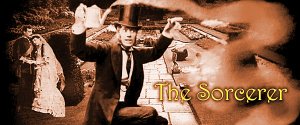You are here: > > Glossary

Adapted from the book "Tit-Willow or Notes and Jottings on Gilbert and Sullivan Operas" by Guy H. and Claude A. Walmisley (Privately Printed, Undated)
Abudah. In James Ridley's (1736-65) "Tales of the Genii", a merchant of Baghdad, who dreams that every night a box, or chest, enters of itself into his chamber, and discloses a hag who drives him to seek the talisman of Oromanes, which will insure happiness. He learns finally that the real talisman of Oromanes, true happiness, can be enjoyed only by immortals, and that man's sole pursuit should be to know and obey the will of God.
Ahrimanes. or Angra Mainyu, in Persian mythology, the Spiritual Enemy, who is in eternal conflict with Ahura Mazda, or Ormuzd, the Wise Lord. Both have existed from the beginning of the world.
Aurora. The goddess of Dawn. She married Astraeus by whom she had the winds and stars etc.
Aurora is generally represented by the poets drawn in a rose-coloured chariot and opening with her rosy fingers the gates of the east, pouring the dew upon the earth and making the flowers grow. Her chariot is generally drawn by white horses and she is covered with a veil. Nox (Night) and Somnus (Sleep) fly before her, and the constellations of heaven disappear at her approach. She always sets out before the Sun and is the forerunner of his rising. The Greeks called her Eos.
Blind young boy. The Cupid. In Roman mythology he was the god of love, son of Venus, and usually represented as a naked, winged boy with a bow and arrow.
Djinn. In Persian and Mohammedan mythology, the Djinns were created 2000 years before Adam, but sinned against God and were degraded from their original high estate. The greatest among them was Eblis, cast out by Allah for refusing to worship Adam. Djinns were made from pure flame, and were ever busy fermenting evil, calamities and injuries. They lived chiefly on the mountains of Kaf, which encompass the whole earth.
Helen of Troy. The most beautiful woman of her age, who had numberless suitors. She married Menelaus. Paris, son of Priam, King of Troy came to Lacedaemon on pretence of sacrificing to Apollo and was kindly received by Menelaus. Paris, however, persuaded Helen to follow him to Troy in 1198 B.C. and this led to the ten years war--Menelaus and the Greek princes besieging Troy. Paris was killed in the 9th year and Helen voluntarily married Deiphobus, another of Priam's sons, but betrayed him by introducing the Greeks into his chamber, and having thus ingratiated herself with Menelaus, who forgave her, she returned with him to Sparta.
Hogshead. A large cask or barrel, especially one containing from 100 to 140 gallons.
K.C.B. Knight Commander of the Bath. For a full description see "The Gondoliers" "Notes".
'Lectro biology. Electro biology or animal magnetism. A phrase of mesmerism.
Electro biology, or biology (as it was very commonly designated) became a fashionable amusement in some circles at ordinary evening parties.
Lunn, Sally. A tea cake; so called from Sally Lunn, the pastry-cook of Bath, who used to cry them about in a basket at the close of the 18th century. Dalmer, a respectable baker and musician, noticed her, bought up her business and wrote a song about her.
These particular tea cakes should be cut open, well-buttered, and served hot.
Melt a rich uncle in wax. A waxen image. Especially an effigy in wax representing a person whom it was desired to injure by witchcraft. The victim was believed to waste away as the wax melted at the fire, and suffer pain from stabs, or the like, inflicted on the effigy.
Shakespeare mentions the following in his "Two Gentlemen of Verona" (Act 2 Scene 4; 201.) ". . . for now my love is thaw'd; which, like a waxen image 'gainst a fire bears no impression of the thing it was."
Rosetti, also, in his poem "Sister Helen" described how this form of black magic worked. "Why did you melt your waxen man, Sister Helen? Today is the third since you began ...... "Oh the waxen knave was plump today ... how like dead folk he has dropped away!"
The earliest conviction in Scotland for witchcraft is supposed to have been in 1479, "for consuming a waxen image of the king".
Nosology. The branch of medical science which treats of diseases.
One Tree Hill. Greenwich. So called from a large tree growing in the park there, although two prints of Peter Tilleman's published in 1746 and 1774 depicts the hill, but no tree. In the days of Greenwich Fair the hill was often rolled down.
Paris, That affair with. Son of Priam, King of Troy. For further details, see above under Helen of Troy.
|
Page Created 16 August, 2011
